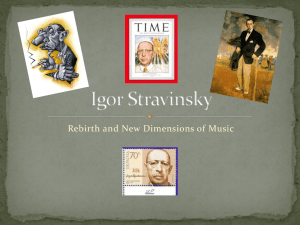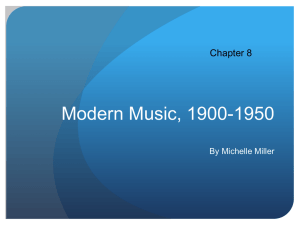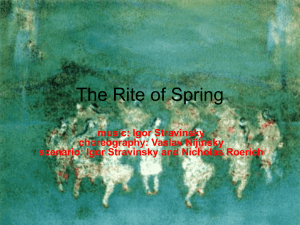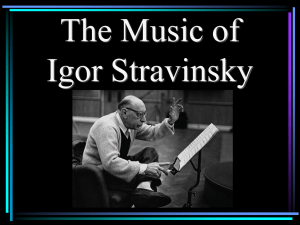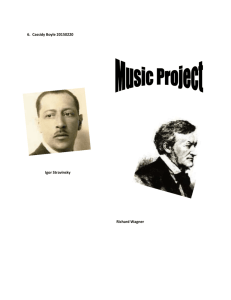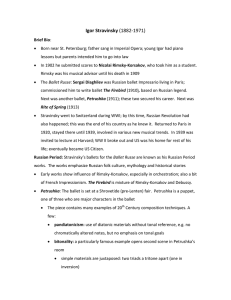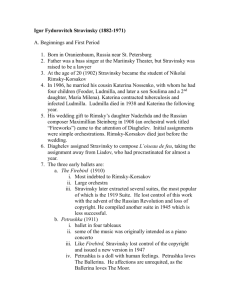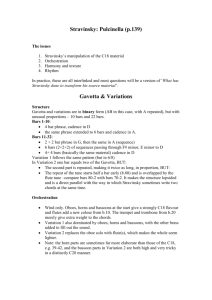Mr. Robert L. Johnston
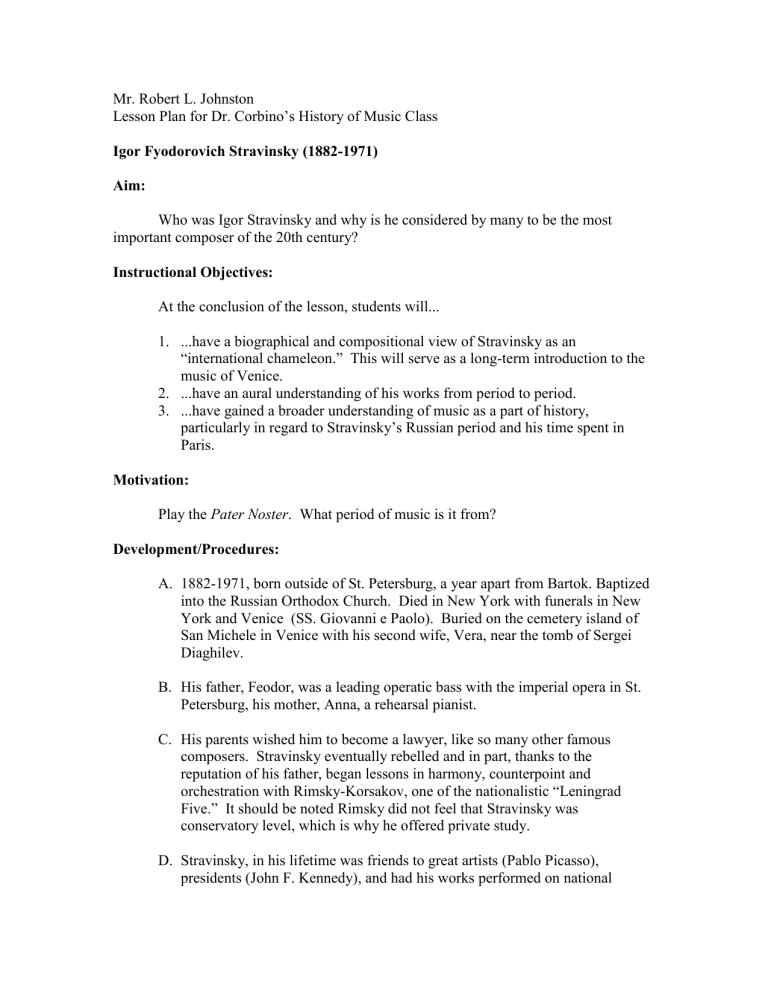
Mr. Robert L. Johnston
Lesson Plan for Dr. Corbino’s History of Music Class
Igor Fyodorovich Stravinsky (1882-1971)
Aim:
Who was Igor Stravinsky and why is he considered by many to be the most important composer of the 20th century?
Instructional Objectives:
At the conclusion of the lesson, students will...
1.
...have a biographical and compositional view of Stravinsky as an
“international chameleon.” This will serve as a long-term introduction to the music of Venice.
2.
...have an aural understanding of his works from period to period.
3.
...have gained a broader understanding of music as a part of history, particularly in regard to Stravinsky’s Russian period and his time spent in
Paris.
Motivation:
Play the Pater Noster . What period of music is it from?
Development/Procedures:
A.
1882-1971, born outside of St. Petersburg, a year apart from Bartok. Baptized into the Russian Orthodox Church. Died in New York with funerals in New
York and Venice (SS. Giovanni e Paolo). Buried on the cemetery island of
San Michele in Venice with his second wife, Vera, near the tomb of Sergei
Diaghilev.
B.
His father, Feodor, was a leading operatic bass with the imperial opera in St.
Petersburg, his mother, Anna, a rehearsal pianist.
C.
His parents wished him to become a lawyer, like so many other famous composers. Stravinsky eventually rebelled and in part, thanks to the reputation of his father, began lessons in harmony, counterpoint and orchestration with Rimsky-Korsakov, one of the nationalistic “Leningrad
Five.” It should be noted Rimsky did not feel that Stravinsky was conservatory level, which is why he offered private study.
D.
Stravinsky, in his lifetime was friends to great artists (Pablo Picasso), presidents (John F. Kennedy), and had his works performed on national
television (June 14, 1962, The Flood appears on CBS Television). His life was long enough that he saw premieres of the music of Brahms and saw
Tchaikowsky conduct. His life ended less than two years after Woodstock and he witnessed two world wars, the Russian Revolution, the Korean
Conflict, the Viet Nam War, space flight and man landing on the moon, and his death is concurrent with the birth of disco.
E.
In February 1909, Sergei Diaghilev, the Russian patron of the Ballet Russe attended a performance of Stravinsky’s Fireworks , which opened the door to
Stravinsky’s most successful period, his Russian period.
***Listening Example, Fireworks ***
F.
The Russian period is generally characterized by three major works; all ballets and all for Diaghilev’s Ballet Russe. They are, chronologically,
The
Firebird, Petrouchka and The Rite of Spring. All of the works from this period draw heavily on Russian folk music, much like Bartok’s music did.
G.
May 29, 1913, The Rite of Spring, Stravinsky’s most infamous and controversial work is premiered at the Theatre des Champs-Elysees in Paris to a veritable who’s who. The famous dancer-choreographer (and Diaghilev’s lover), Vaslav Nijinsky choreographed and was soon thereafter institutionalized and later died. Saint-Saens is said to have been one of the more vocal protesters. World War I is a year away.
***Listening Example, The Rite of Spring ***
“The first two minutes apparently went well, with the audience enthralled by the haunting introduction. But then, the astringent brutality of the first scene broke through as, in
Stravinsky's words: “the curtain rose on a group of knock-kneed and long-braided Lolitas jumping up and down.” The subject itself was scandalous: instead of the fanciful amorous stuff of fluffy ballet dreams, ugly pagans sacrifice a maiden to propitiate the gods of spring. The choreography, costumes and sets boldly dispensed with grace and beauty to emphasize awkward, primitive starkness. At first there were a few boos and catcalls, but then a storm broke as the outraged audience reacted by yelling and fighting. Diaghilev tried to quell the disturbance by switching the house lights on and off while Nijinski tried to sustain the performance as best he could by shouting out numbers and cues to the dancers, who couldn't hear the music, loud as it was, over the din. Stravinsky was furious and stormed out of the theater before police arrived to end the show.”
(http://www.classicalnotes.net/classics/rite.html)
H.
Stravinsky is greatly influenced by American jazz music, having been exposed to it in Paris. Works such as
The Soldier’s Tale, Rag-Time and
Piano-Rag Music are indicative of this next period. By this time, Russia has fallen into; Stravinsky will live in France during this period and his
approaching neo-classic period . Later in his career (1945), Stravinsky wrote
The Ebony Concerto for the great American Jazz clarinetist, Benny Goodman.
1.
In Paris at the time were also Picasso, Nadia Boulanger, Aaron
Copland, Josephine Baker, Paul Whiteman, Coleman Hawkins, Coco
Chanel, Edgar Varese and Carlos Salzado, among others.
***Listening Example, Piano-Rag Music , Igor Stravinsky, piano***
Stravinsky wrote, “...I stressed the percussion possibilities of the piano.”
This is an imperative insight into the understanding not only of Stravinsky’s constant revisions but also of his music as a whole
***Listening Example, The Ebony Concerto , Benny Goodman, clarinet***
I.
Stravinsky, on insistence from Diaghilev writes Pulcinella in 1919-20, one of the premiere works of his neo-classic period . It is based on the music of the
18th century Italian composer, Giovanni Pergolesi. This work opens the door on a new compositional style used by numerous composers, such as Ottorino
Respighi for the same Ballet Russe, to come. Another important work from this time is the Octet .
"A good composer does not imitate, he steals." –Igor Stravinsky
***Listening Examples, Pulcinella , Overture ***
J.
As indicated by Dr. Corbino, musical periods do not conform to cut-and-dry dates. Therefore observe the following:
***Listening Example, Symphony in C , I. Moderato alla breve, half-note=66***
Compare to famous Romantic work
K.
Stravinsky found renewed faith in the Russian Orthodox Church in 1926 and wrote a number of liturgical works. Probably the most famous is Symphony of Psalms from 1930. Stravinsky wrote, “...one hopes to worship God with a little art if one has any.” The work
Canticum Sacrum (1955) is an excellent example of Stravinsky’s faith and connection with the city of Venice, Italy.
Stravinsky’s great opera, The Rake’s Progress , was premiered in La Fenice,
Venice’s opera house.
***Listening example, Canticum Sacrum ***
Note, all the texts are liturgical
The correlations to Venice are...
Work written for the Biennale Festival
Work inscribed to St. Mark, the “patron saint” of Venice
The work is written with acoustical consideration for performance in the Basilica di S.
Marco
The cyclical form of the work is said to be analogous to the five domes of the Basilica di
S. Marco (five movements, five domes, see picture)
Use of antiphonal devices (cori spezzatti), consideration for the organ and mixed instrumental ensembles are all facets of Venetian music
L.
Stravinsky enters his serial , though not necessarily twelve-tone period with In
Memoriam Dylan Thomas , for the poet he had hoped to produce an opera with. This work, written well after Schoenberg enters his serial period, uses not a twelve tone row, but a five tone row.
***Listening Example, In Memoriam Dylan Thomas ***
M.
Stravinsky continued to write works with a historical basis. He was a great admirer of three composers in particular. Tachaikowsky, who he saw conduct,
Debussy, who he met and Gesualdo. In 1960 he recomposed three madrigals of Gesualdo for orchestra.
***Listening Example, Monumentum pro Gesualdo di Venosa ***
N.
Pictures
Materials of Instruction:
The Igor Stravinsky Edition on Sony Classical, owned by the music department:
Includes compact disc recordings and various pictures and paintings from the liner notes.
Summary:
Stravinsky lived the last thirty-one years of his life on the west coast (Hollywood) just blocks away from Arnold Schoenberg. His personal assistant, Robert Craft, is still alive today. Stravinsky and Craft were instrumental in the organization of the Eveningson-the-Roof Monday-Evening-Concerts concert series in Los Angeles that presented concerts of music from the Renaissance to the Contemporary. Stravinsky had a compositional life of 68 years. The total running time of his music is approximately 24 hours, a day of music. His works included ballets for the Ballet Russe and the New York
City ballet and George Ballanchine, symphonies, concertos, chamber music, operas, songs, chamber music, and liturgical music. His music employs folk music, old music, new music, atonal and serial music. His piano works were written with himself or his son in mind as soloist and feature virtuosic parts written for their hands that could reach tenths on the piano. He is, undoubtedly one of the most important composers of our or
any time.
Assignment:
Attend Dr. David Noon’s free Stravinsky concert in December at the Manhattan
School of Music (212) 749-2802. Recognize the New York area conservatories as a resource for free, live music of all genres.
Bibliography:
White, Eric Walter. Stravinsky, The Composer and his Works. Berkely: 1979. 656 pp.
The Igor Stravinsky Edition of recordings on Sony Classical, compiled and released,
1991.
Suggested Reference: http://www.boosey.com/pages/cr/composer/timeline.asp?composerid=2708&langid=1
Robert L. Johnston
